ECO600: KFC and Oporto - Competitive Strategies and Finance Report
VerifiedAdded on 2022/11/17
|10
|3357
|285
Report
AI Summary
This report provides a comprehensive analysis of KFC and Oporto, two prominent players in the Australian fast-food industry. It begins with an abstract summarizing the key findings, followed by an introduction that outlines the report's objectives and methodology, including the use of secondary data from peer-reviewed journals, annual reports, and strategic management books. The report then delves into the market structure and corporate strategies of both companies, examining their competitive positions within the Australian fast-food sector, including market share and the Herfindahl-Hirschman Index. It analyzes product differentiation strategies, such as KFC's extensive menu and secret recipe, and Oporto's Portuguese-themed offerings. Proposals for improving competitiveness, particularly for Oporto, are suggested, focusing on product differentiation and cost leadership. The report also evaluates the growth strategies of both companies, including new product development, product differentiation, and horizontal growth strategies like franchising, with a focus on how KFC leverages its core competencies. It proposes further growth strategies for KFC using the Ansoff Growth Strategy Framework. Finally, the report examines the pricing and non-pricing strategies of KFC and Oporto, highlighting similarities and differences, and suggesting improvements. The report concludes with a summary of the key findings and recommendations, providing valuable insights into the competitive dynamics and strategic approaches of these two fast-food chains. The report is based on an assignment brief for ECO600 Economics and Finance for Business at ICMS.
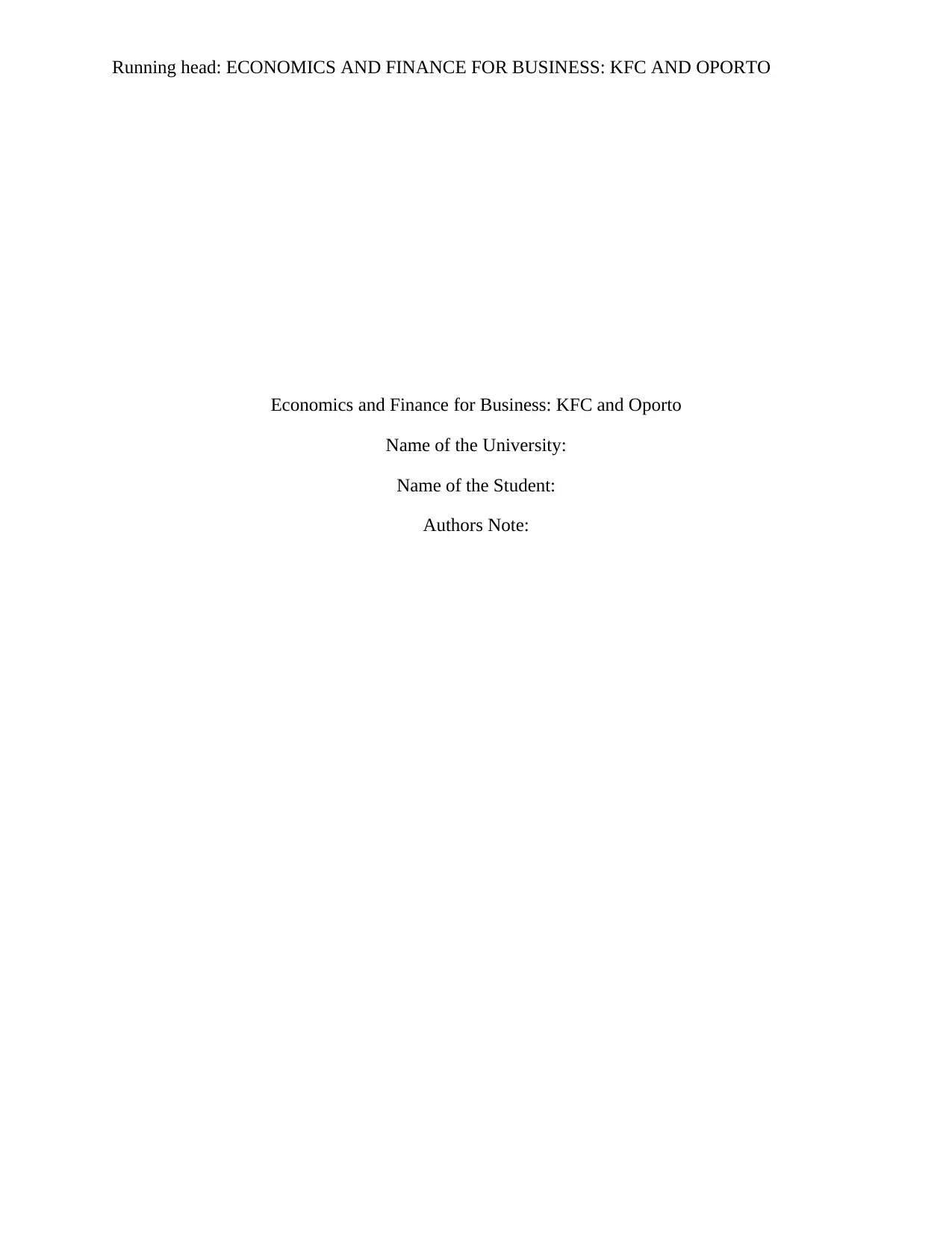
Running head: ECONOMICS AND FINANCE FOR BUSINESS: KFC AND OPORTO
Economics and Finance for Business: KFC and Oporto
Name of the University:
Name of the Student:
Authors Note:
Economics and Finance for Business: KFC and Oporto
Name of the University:
Name of the Student:
Authors Note:
Paraphrase This Document
Need a fresh take? Get an instant paraphrase of this document with our AI Paraphraser
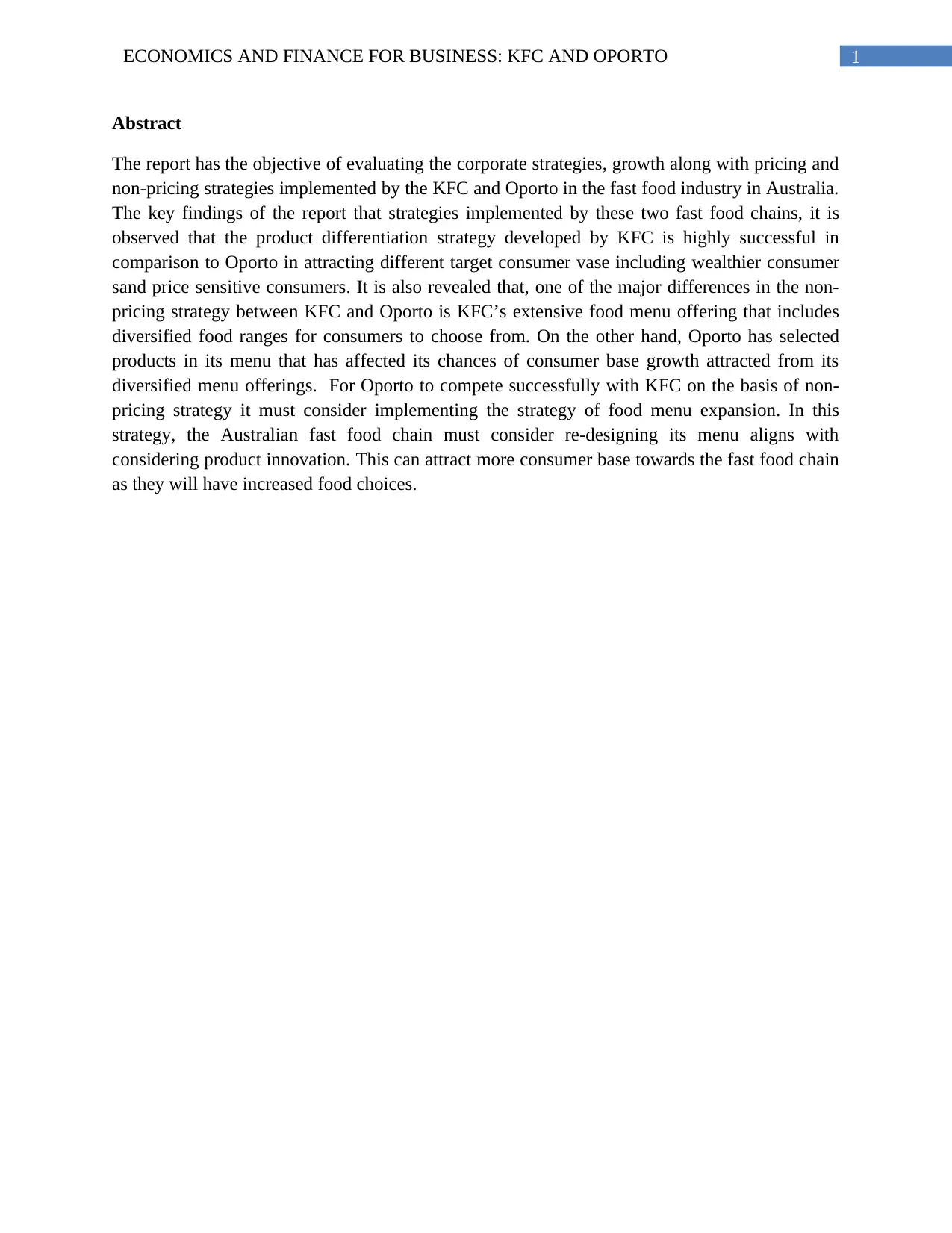
1ECONOMICS AND FINANCE FOR BUSINESS: KFC AND OPORTO
Abstract
The report has the objective of evaluating the corporate strategies, growth along with pricing and
non-pricing strategies implemented by the KFC and Oporto in the fast food industry in Australia.
The key findings of the report that strategies implemented by these two fast food chains, it is
observed that the product differentiation strategy developed by KFC is highly successful in
comparison to Oporto in attracting different target consumer vase including wealthier consumer
sand price sensitive consumers. It is also revealed that, one of the major differences in the non-
pricing strategy between KFC and Oporto is KFC’s extensive food menu offering that includes
diversified food ranges for consumers to choose from. On the other hand, Oporto has selected
products in its menu that has affected its chances of consumer base growth attracted from its
diversified menu offerings. For Oporto to compete successfully with KFC on the basis of non-
pricing strategy it must consider implementing the strategy of food menu expansion. In this
strategy, the Australian fast food chain must consider re-designing its menu aligns with
considering product innovation. This can attract more consumer base towards the fast food chain
as they will have increased food choices.
Abstract
The report has the objective of evaluating the corporate strategies, growth along with pricing and
non-pricing strategies implemented by the KFC and Oporto in the fast food industry in Australia.
The key findings of the report that strategies implemented by these two fast food chains, it is
observed that the product differentiation strategy developed by KFC is highly successful in
comparison to Oporto in attracting different target consumer vase including wealthier consumer
sand price sensitive consumers. It is also revealed that, one of the major differences in the non-
pricing strategy between KFC and Oporto is KFC’s extensive food menu offering that includes
diversified food ranges for consumers to choose from. On the other hand, Oporto has selected
products in its menu that has affected its chances of consumer base growth attracted from its
diversified menu offerings. For Oporto to compete successfully with KFC on the basis of non-
pricing strategy it must consider implementing the strategy of food menu expansion. In this
strategy, the Australian fast food chain must consider re-designing its menu aligns with
considering product innovation. This can attract more consumer base towards the fast food chain
as they will have increased food choices.
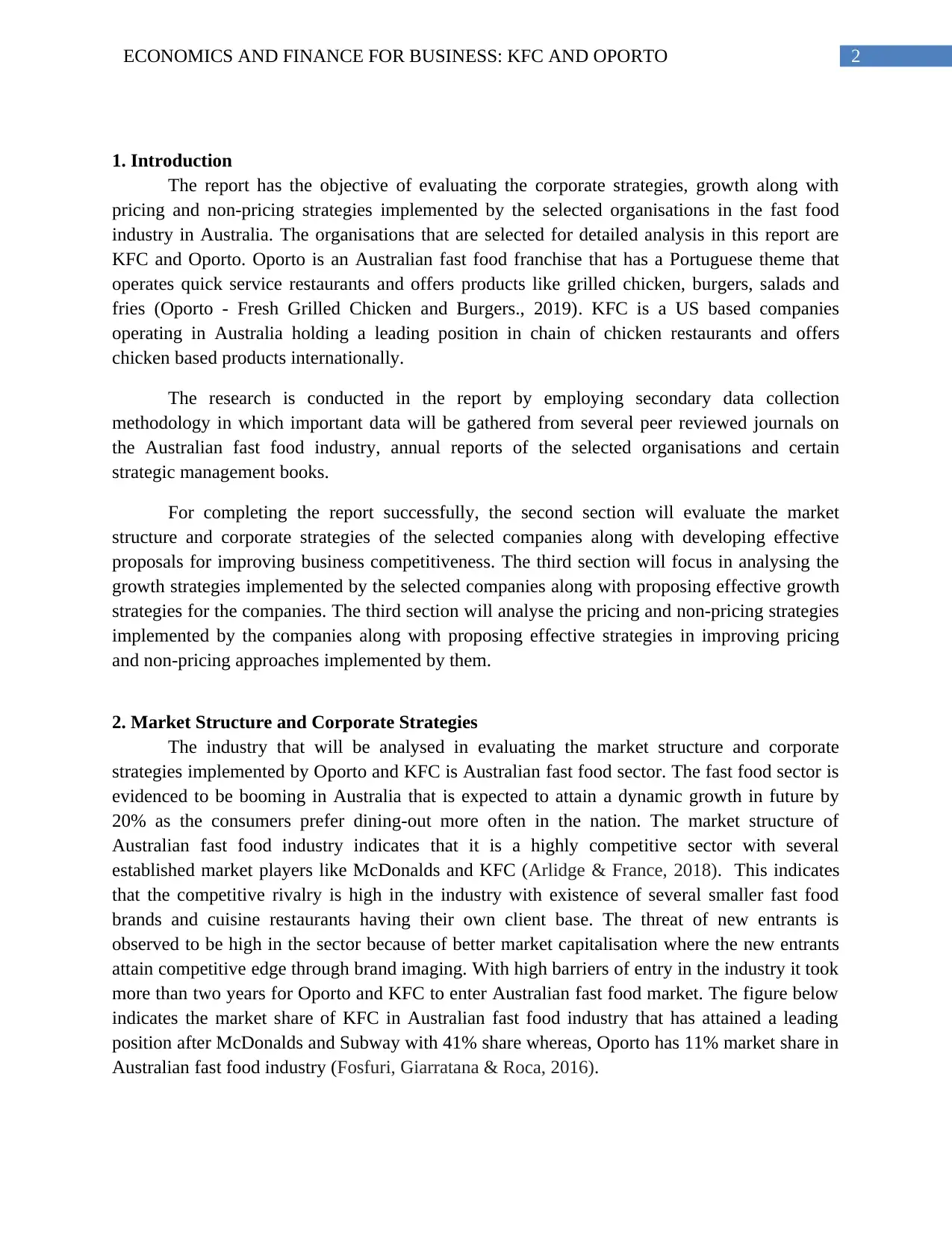
2ECONOMICS AND FINANCE FOR BUSINESS: KFC AND OPORTO
1. Introduction
The report has the objective of evaluating the corporate strategies, growth along with
pricing and non-pricing strategies implemented by the selected organisations in the fast food
industry in Australia. The organisations that are selected for detailed analysis in this report are
KFC and Oporto. Oporto is an Australian fast food franchise that has a Portuguese theme that
operates quick service restaurants and offers products like grilled chicken, burgers, salads and
fries (Oporto - Fresh Grilled Chicken and Burgers., 2019). KFC is a US based companies
operating in Australia holding a leading position in chain of chicken restaurants and offers
chicken based products internationally.
The research is conducted in the report by employing secondary data collection
methodology in which important data will be gathered from several peer reviewed journals on
the Australian fast food industry, annual reports of the selected organisations and certain
strategic management books.
For completing the report successfully, the second section will evaluate the market
structure and corporate strategies of the selected companies along with developing effective
proposals for improving business competitiveness. The third section will focus in analysing the
growth strategies implemented by the selected companies along with proposing effective growth
strategies for the companies. The third section will analyse the pricing and non-pricing strategies
implemented by the companies along with proposing effective strategies in improving pricing
and non-pricing approaches implemented by them.
2. Market Structure and Corporate Strategies
The industry that will be analysed in evaluating the market structure and corporate
strategies implemented by Oporto and KFC is Australian fast food sector. The fast food sector is
evidenced to be booming in Australia that is expected to attain a dynamic growth in future by
20% as the consumers prefer dining-out more often in the nation. The market structure of
Australian fast food industry indicates that it is a highly competitive sector with several
established market players like McDonalds and KFC (Arlidge & France, 2018). This indicates
that the competitive rivalry is high in the industry with existence of several smaller fast food
brands and cuisine restaurants having their own client base. The threat of new entrants is
observed to be high in the sector because of better market capitalisation where the new entrants
attain competitive edge through brand imaging. With high barriers of entry in the industry it took
more than two years for Oporto and KFC to enter Australian fast food market. The figure below
indicates the market share of KFC in Australian fast food industry that has attained a leading
position after McDonalds and Subway with 41% share whereas, Oporto has 11% market share in
Australian fast food industry (Fosfuri, Giarratana & Roca, 2016).
1. Introduction
The report has the objective of evaluating the corporate strategies, growth along with
pricing and non-pricing strategies implemented by the selected organisations in the fast food
industry in Australia. The organisations that are selected for detailed analysis in this report are
KFC and Oporto. Oporto is an Australian fast food franchise that has a Portuguese theme that
operates quick service restaurants and offers products like grilled chicken, burgers, salads and
fries (Oporto - Fresh Grilled Chicken and Burgers., 2019). KFC is a US based companies
operating in Australia holding a leading position in chain of chicken restaurants and offers
chicken based products internationally.
The research is conducted in the report by employing secondary data collection
methodology in which important data will be gathered from several peer reviewed journals on
the Australian fast food industry, annual reports of the selected organisations and certain
strategic management books.
For completing the report successfully, the second section will evaluate the market
structure and corporate strategies of the selected companies along with developing effective
proposals for improving business competitiveness. The third section will focus in analysing the
growth strategies implemented by the selected companies along with proposing effective growth
strategies for the companies. The third section will analyse the pricing and non-pricing strategies
implemented by the companies along with proposing effective strategies in improving pricing
and non-pricing approaches implemented by them.
2. Market Structure and Corporate Strategies
The industry that will be analysed in evaluating the market structure and corporate
strategies implemented by Oporto and KFC is Australian fast food sector. The fast food sector is
evidenced to be booming in Australia that is expected to attain a dynamic growth in future by
20% as the consumers prefer dining-out more often in the nation. The market structure of
Australian fast food industry indicates that it is a highly competitive sector with several
established market players like McDonalds and KFC (Arlidge & France, 2018). This indicates
that the competitive rivalry is high in the industry with existence of several smaller fast food
brands and cuisine restaurants having their own client base. The threat of new entrants is
observed to be high in the sector because of better market capitalisation where the new entrants
attain competitive edge through brand imaging. With high barriers of entry in the industry it took
more than two years for Oporto and KFC to enter Australian fast food market. The figure below
indicates the market share of KFC in Australian fast food industry that has attained a leading
position after McDonalds and Subway with 41% share whereas, Oporto has 11% market share in
Australian fast food industry (Fosfuri, Giarratana & Roca, 2016).
⊘ This is a preview!⊘
Do you want full access?
Subscribe today to unlock all pages.

Trusted by 1+ million students worldwide
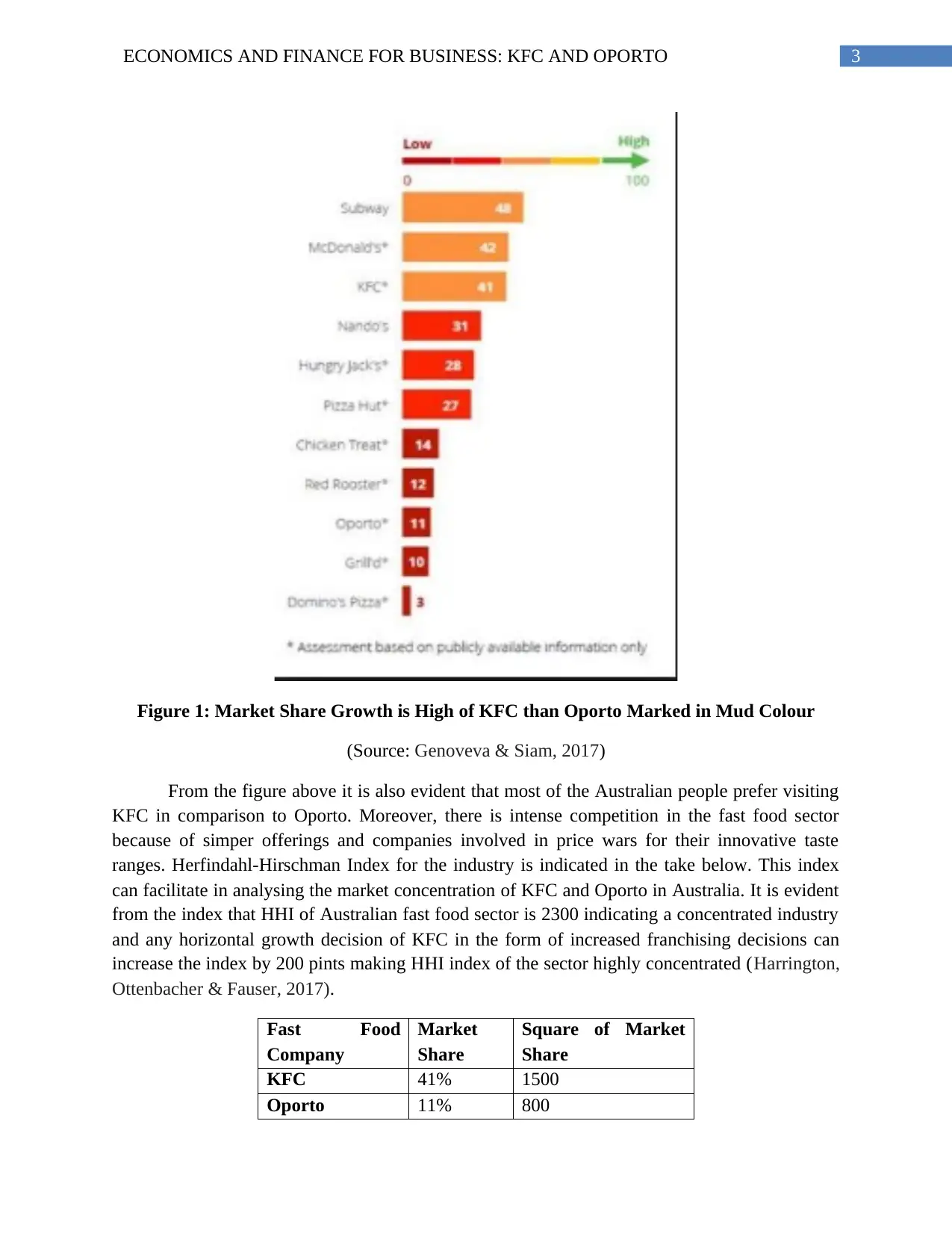
3ECONOMICS AND FINANCE FOR BUSINESS: KFC AND OPORTO
Figure 1: Market Share Growth is High of KFC than Oporto Marked in Mud Colour
(Source: Genoveva & Siam, 2017)
From the figure above it is also evident that most of the Australian people prefer visiting
KFC in comparison to Oporto. Moreover, there is intense competition in the fast food sector
because of simper offerings and companies involved in price wars for their innovative taste
ranges. Herfindahl-Hirschman Index for the industry is indicated in the take below. This index
can facilitate in analysing the market concentration of KFC and Oporto in Australia. It is evident
from the index that HHI of Australian fast food sector is 2300 indicating a concentrated industry
and any horizontal growth decision of KFC in the form of increased franchising decisions can
increase the index by 200 pints making HHI index of the sector highly concentrated (Harrington,
Ottenbacher & Fauser, 2017).
Fast Food
Company
Market
Share
Square of Market
Share
KFC 41% 1500
Oporto 11% 800
Figure 1: Market Share Growth is High of KFC than Oporto Marked in Mud Colour
(Source: Genoveva & Siam, 2017)
From the figure above it is also evident that most of the Australian people prefer visiting
KFC in comparison to Oporto. Moreover, there is intense competition in the fast food sector
because of simper offerings and companies involved in price wars for their innovative taste
ranges. Herfindahl-Hirschman Index for the industry is indicated in the take below. This index
can facilitate in analysing the market concentration of KFC and Oporto in Australia. It is evident
from the index that HHI of Australian fast food sector is 2300 indicating a concentrated industry
and any horizontal growth decision of KFC in the form of increased franchising decisions can
increase the index by 200 pints making HHI index of the sector highly concentrated (Harrington,
Ottenbacher & Fauser, 2017).
Fast Food
Company
Market
Share
Square of Market
Share
KFC 41% 1500
Oporto 11% 800
Paraphrase This Document
Need a fresh take? Get an instant paraphrase of this document with our AI Paraphraser
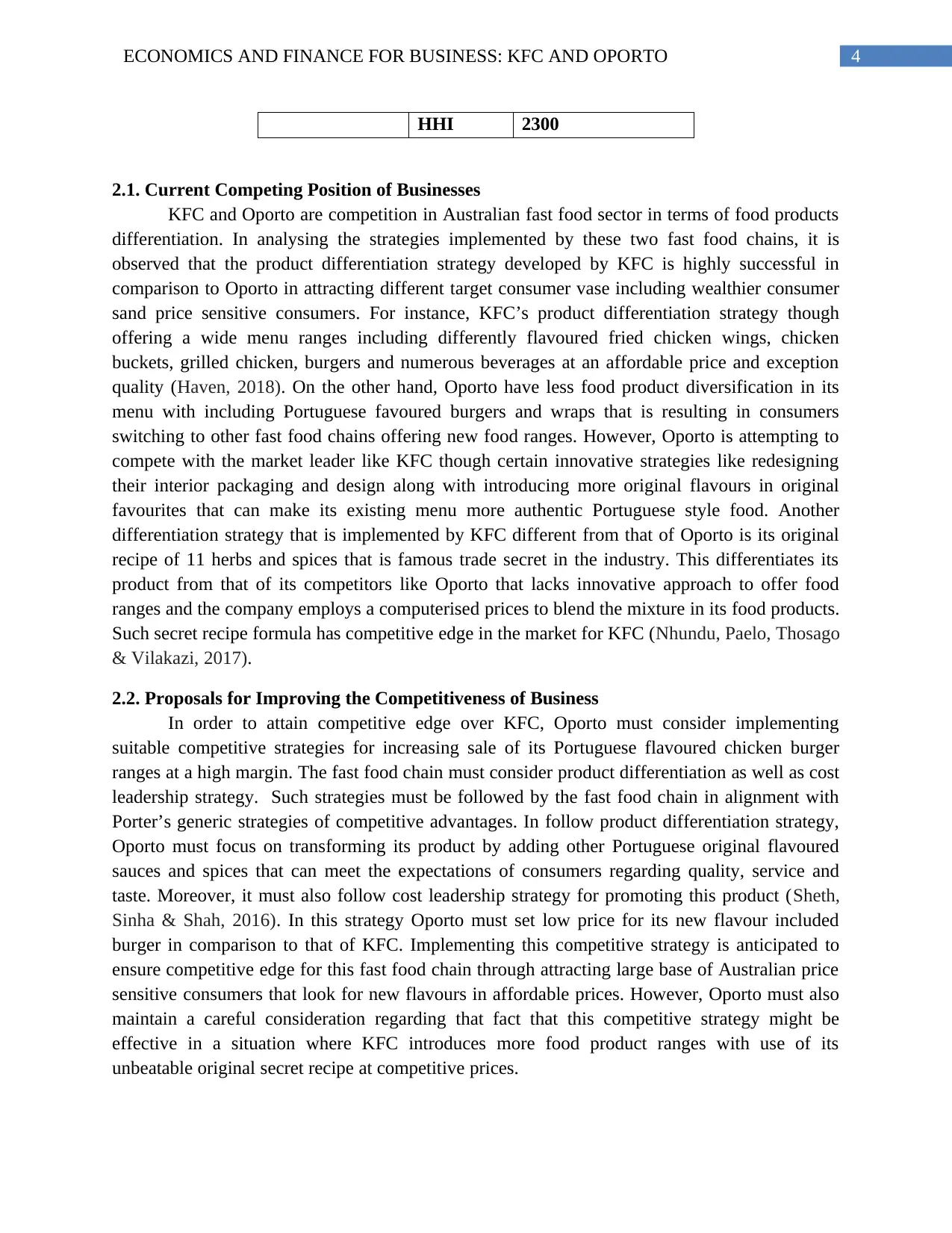
4ECONOMICS AND FINANCE FOR BUSINESS: KFC AND OPORTO
HHI 2300
2.1. Current Competing Position of Businesses
KFC and Oporto are competition in Australian fast food sector in terms of food products
differentiation. In analysing the strategies implemented by these two fast food chains, it is
observed that the product differentiation strategy developed by KFC is highly successful in
comparison to Oporto in attracting different target consumer vase including wealthier consumer
sand price sensitive consumers. For instance, KFC’s product differentiation strategy though
offering a wide menu ranges including differently flavoured fried chicken wings, chicken
buckets, grilled chicken, burgers and numerous beverages at an affordable price and exception
quality (Haven, 2018). On the other hand, Oporto have less food product diversification in its
menu with including Portuguese favoured burgers and wraps that is resulting in consumers
switching to other fast food chains offering new food ranges. However, Oporto is attempting to
compete with the market leader like KFC though certain innovative strategies like redesigning
their interior packaging and design along with introducing more original flavours in original
favourites that can make its existing menu more authentic Portuguese style food. Another
differentiation strategy that is implemented by KFC different from that of Oporto is its original
recipe of 11 herbs and spices that is famous trade secret in the industry. This differentiates its
product from that of its competitors like Oporto that lacks innovative approach to offer food
ranges and the company employs a computerised prices to blend the mixture in its food products.
Such secret recipe formula has competitive edge in the market for KFC (Nhundu, Paelo, Thosago
& Vilakazi, 2017).
2.2. Proposals for Improving the Competitiveness of Business
In order to attain competitive edge over KFC, Oporto must consider implementing
suitable competitive strategies for increasing sale of its Portuguese flavoured chicken burger
ranges at a high margin. The fast food chain must consider product differentiation as well as cost
leadership strategy. Such strategies must be followed by the fast food chain in alignment with
Porter’s generic strategies of competitive advantages. In follow product differentiation strategy,
Oporto must focus on transforming its product by adding other Portuguese original flavoured
sauces and spices that can meet the expectations of consumers regarding quality, service and
taste. Moreover, it must also follow cost leadership strategy for promoting this product (Sheth,
Sinha & Shah, 2016). In this strategy Oporto must set low price for its new flavour included
burger in comparison to that of KFC. Implementing this competitive strategy is anticipated to
ensure competitive edge for this fast food chain through attracting large base of Australian price
sensitive consumers that look for new flavours in affordable prices. However, Oporto must also
maintain a careful consideration regarding that fact that this competitive strategy might be
effective in a situation where KFC introduces more food product ranges with use of its
unbeatable original secret recipe at competitive prices.
HHI 2300
2.1. Current Competing Position of Businesses
KFC and Oporto are competition in Australian fast food sector in terms of food products
differentiation. In analysing the strategies implemented by these two fast food chains, it is
observed that the product differentiation strategy developed by KFC is highly successful in
comparison to Oporto in attracting different target consumer vase including wealthier consumer
sand price sensitive consumers. For instance, KFC’s product differentiation strategy though
offering a wide menu ranges including differently flavoured fried chicken wings, chicken
buckets, grilled chicken, burgers and numerous beverages at an affordable price and exception
quality (Haven, 2018). On the other hand, Oporto have less food product diversification in its
menu with including Portuguese favoured burgers and wraps that is resulting in consumers
switching to other fast food chains offering new food ranges. However, Oporto is attempting to
compete with the market leader like KFC though certain innovative strategies like redesigning
their interior packaging and design along with introducing more original flavours in original
favourites that can make its existing menu more authentic Portuguese style food. Another
differentiation strategy that is implemented by KFC different from that of Oporto is its original
recipe of 11 herbs and spices that is famous trade secret in the industry. This differentiates its
product from that of its competitors like Oporto that lacks innovative approach to offer food
ranges and the company employs a computerised prices to blend the mixture in its food products.
Such secret recipe formula has competitive edge in the market for KFC (Nhundu, Paelo, Thosago
& Vilakazi, 2017).
2.2. Proposals for Improving the Competitiveness of Business
In order to attain competitive edge over KFC, Oporto must consider implementing
suitable competitive strategies for increasing sale of its Portuguese flavoured chicken burger
ranges at a high margin. The fast food chain must consider product differentiation as well as cost
leadership strategy. Such strategies must be followed by the fast food chain in alignment with
Porter’s generic strategies of competitive advantages. In follow product differentiation strategy,
Oporto must focus on transforming its product by adding other Portuguese original flavoured
sauces and spices that can meet the expectations of consumers regarding quality, service and
taste. Moreover, it must also follow cost leadership strategy for promoting this product (Sheth,
Sinha & Shah, 2016). In this strategy Oporto must set low price for its new flavour included
burger in comparison to that of KFC. Implementing this competitive strategy is anticipated to
ensure competitive edge for this fast food chain through attracting large base of Australian price
sensitive consumers that look for new flavours in affordable prices. However, Oporto must also
maintain a careful consideration regarding that fact that this competitive strategy might be
effective in a situation where KFC introduces more food product ranges with use of its
unbeatable original secret recipe at competitive prices.
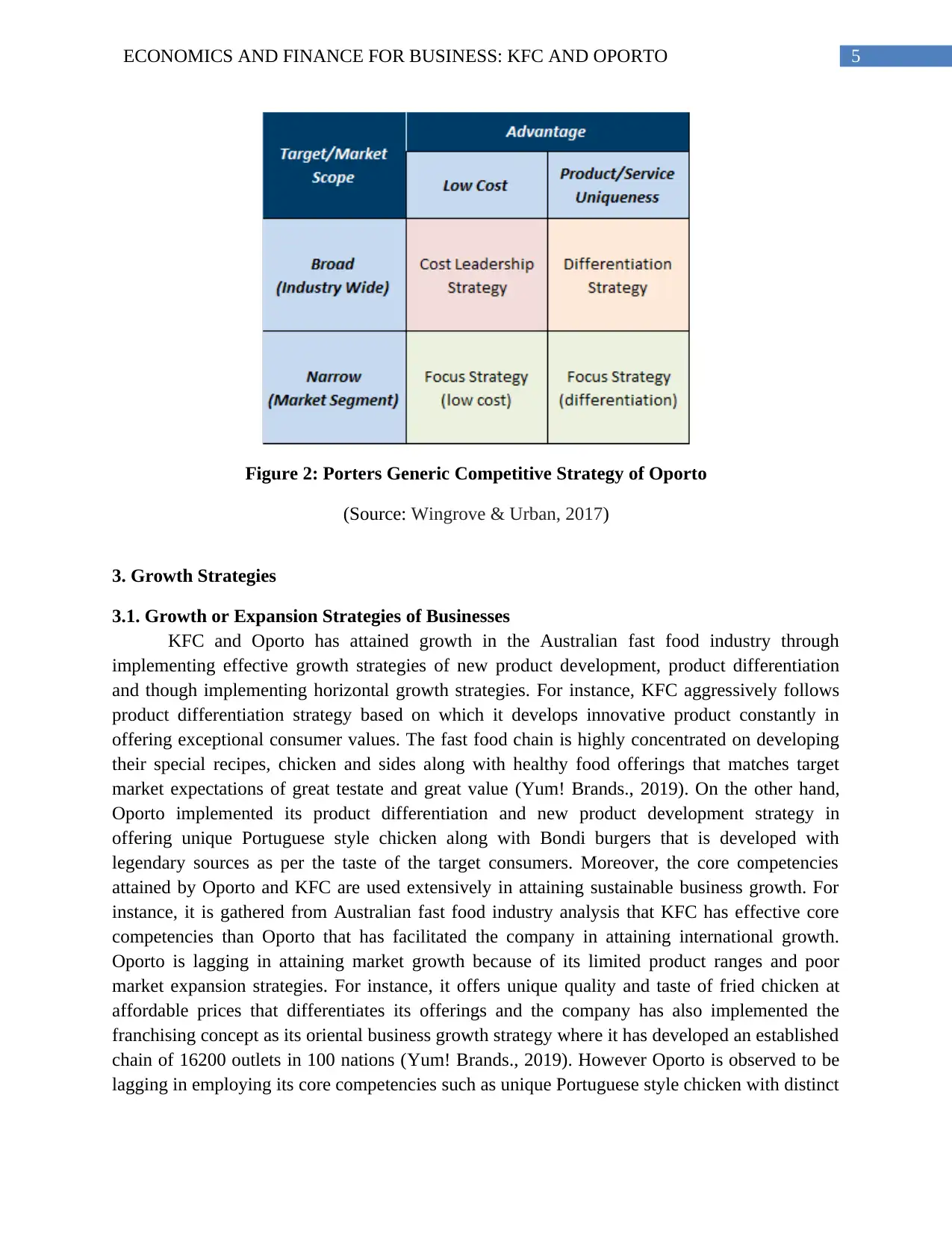
5ECONOMICS AND FINANCE FOR BUSINESS: KFC AND OPORTO
Figure 2: Porters Generic Competitive Strategy of Oporto
(Source: Wingrove & Urban, 2017)
3. Growth Strategies
3.1. Growth or Expansion Strategies of Businesses
KFC and Oporto has attained growth in the Australian fast food industry through
implementing effective growth strategies of new product development, product differentiation
and though implementing horizontal growth strategies. For instance, KFC aggressively follows
product differentiation strategy based on which it develops innovative product constantly in
offering exceptional consumer values. The fast food chain is highly concentrated on developing
their special recipes, chicken and sides along with healthy food offerings that matches target
market expectations of great testate and great value (Yum! Brands., 2019). On the other hand,
Oporto implemented its product differentiation and new product development strategy in
offering unique Portuguese style chicken along with Bondi burgers that is developed with
legendary sources as per the taste of the target consumers. Moreover, the core competencies
attained by Oporto and KFC are used extensively in attaining sustainable business growth. For
instance, it is gathered from Australian fast food industry analysis that KFC has effective core
competencies than Oporto that has facilitated the company in attaining international growth.
Oporto is lagging in attaining market growth because of its limited product ranges and poor
market expansion strategies. For instance, it offers unique quality and taste of fried chicken at
affordable prices that differentiates its offerings and the company has also implemented the
franchising concept as its oriental business growth strategy where it has developed an established
chain of 16200 outlets in 100 nations (Yum! Brands., 2019). However Oporto is observed to be
lagging in employing its core competencies such as unique Portuguese style chicken with distinct
Figure 2: Porters Generic Competitive Strategy of Oporto
(Source: Wingrove & Urban, 2017)
3. Growth Strategies
3.1. Growth or Expansion Strategies of Businesses
KFC and Oporto has attained growth in the Australian fast food industry through
implementing effective growth strategies of new product development, product differentiation
and though implementing horizontal growth strategies. For instance, KFC aggressively follows
product differentiation strategy based on which it develops innovative product constantly in
offering exceptional consumer values. The fast food chain is highly concentrated on developing
their special recipes, chicken and sides along with healthy food offerings that matches target
market expectations of great testate and great value (Yum! Brands., 2019). On the other hand,
Oporto implemented its product differentiation and new product development strategy in
offering unique Portuguese style chicken along with Bondi burgers that is developed with
legendary sources as per the taste of the target consumers. Moreover, the core competencies
attained by Oporto and KFC are used extensively in attaining sustainable business growth. For
instance, it is gathered from Australian fast food industry analysis that KFC has effective core
competencies than Oporto that has facilitated the company in attaining international growth.
Oporto is lagging in attaining market growth because of its limited product ranges and poor
market expansion strategies. For instance, it offers unique quality and taste of fried chicken at
affordable prices that differentiates its offerings and the company has also implemented the
franchising concept as its oriental business growth strategy where it has developed an established
chain of 16200 outlets in 100 nations (Yum! Brands., 2019). However Oporto is observed to be
lagging in employing its core competencies such as unique Portuguese style chicken with distinct
⊘ This is a preview!⊘
Do you want full access?
Subscribe today to unlock all pages.

Trusted by 1+ million students worldwide
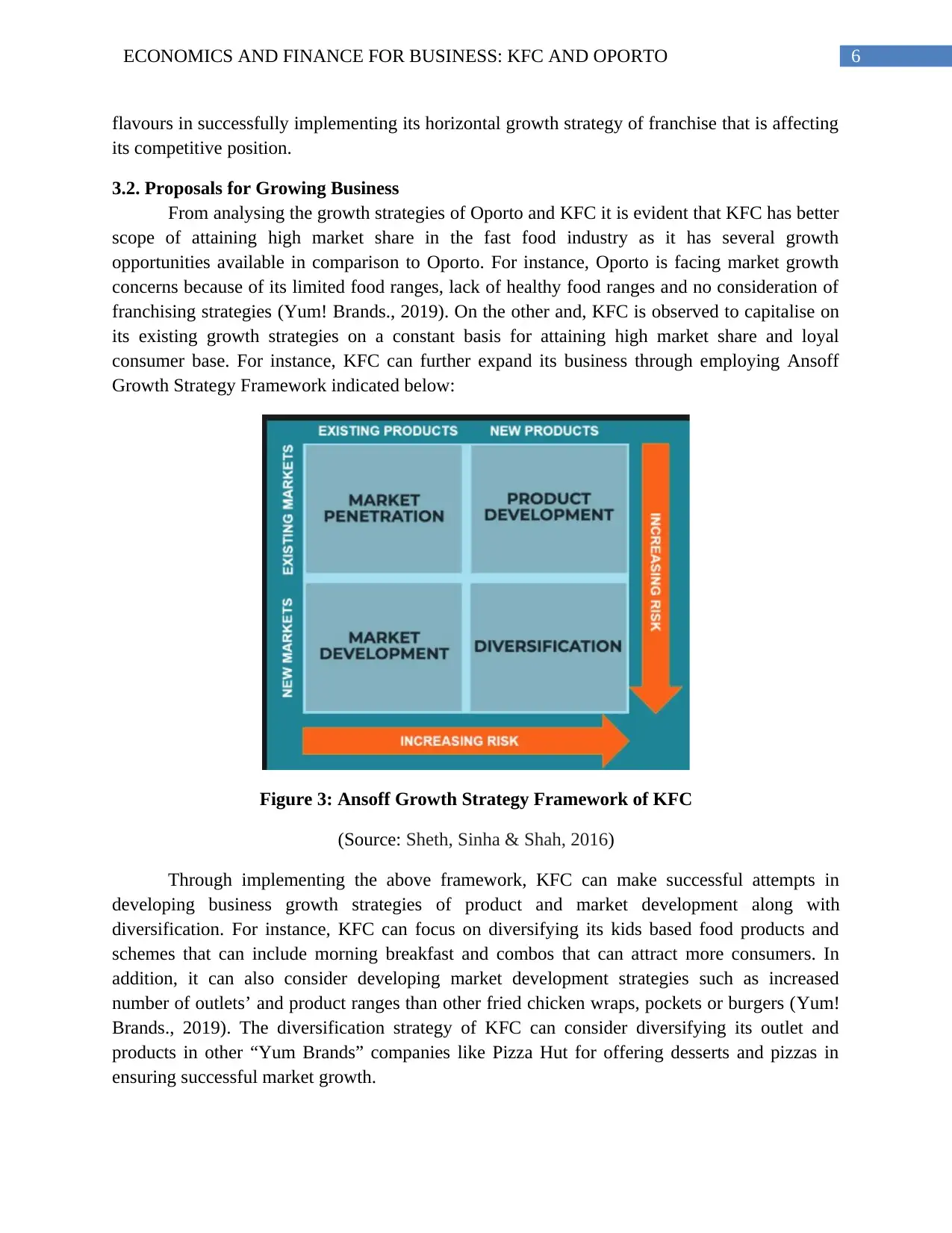
6ECONOMICS AND FINANCE FOR BUSINESS: KFC AND OPORTO
flavours in successfully implementing its horizontal growth strategy of franchise that is affecting
its competitive position.
3.2. Proposals for Growing Business
From analysing the growth strategies of Oporto and KFC it is evident that KFC has better
scope of attaining high market share in the fast food industry as it has several growth
opportunities available in comparison to Oporto. For instance, Oporto is facing market growth
concerns because of its limited food ranges, lack of healthy food ranges and no consideration of
franchising strategies (Yum! Brands., 2019). On the other and, KFC is observed to capitalise on
its existing growth strategies on a constant basis for attaining high market share and loyal
consumer base. For instance, KFC can further expand its business through employing Ansoff
Growth Strategy Framework indicated below:
Figure 3: Ansoff Growth Strategy Framework of KFC
(Source: Sheth, Sinha & Shah, 2016)
Through implementing the above framework, KFC can make successful attempts in
developing business growth strategies of product and market development along with
diversification. For instance, KFC can focus on diversifying its kids based food products and
schemes that can include morning breakfast and combos that can attract more consumers. In
addition, it can also consider developing market development strategies such as increased
number of outlets’ and product ranges than other fried chicken wraps, pockets or burgers (Yum!
Brands., 2019). The diversification strategy of KFC can consider diversifying its outlet and
products in other “Yum Brands” companies like Pizza Hut for offering desserts and pizzas in
ensuring successful market growth.
flavours in successfully implementing its horizontal growth strategy of franchise that is affecting
its competitive position.
3.2. Proposals for Growing Business
From analysing the growth strategies of Oporto and KFC it is evident that KFC has better
scope of attaining high market share in the fast food industry as it has several growth
opportunities available in comparison to Oporto. For instance, Oporto is facing market growth
concerns because of its limited food ranges, lack of healthy food ranges and no consideration of
franchising strategies (Yum! Brands., 2019). On the other and, KFC is observed to capitalise on
its existing growth strategies on a constant basis for attaining high market share and loyal
consumer base. For instance, KFC can further expand its business through employing Ansoff
Growth Strategy Framework indicated below:
Figure 3: Ansoff Growth Strategy Framework of KFC
(Source: Sheth, Sinha & Shah, 2016)
Through implementing the above framework, KFC can make successful attempts in
developing business growth strategies of product and market development along with
diversification. For instance, KFC can focus on diversifying its kids based food products and
schemes that can include morning breakfast and combos that can attract more consumers. In
addition, it can also consider developing market development strategies such as increased
number of outlets’ and product ranges than other fried chicken wraps, pockets or burgers (Yum!
Brands., 2019). The diversification strategy of KFC can consider diversifying its outlet and
products in other “Yum Brands” companies like Pizza Hut for offering desserts and pizzas in
ensuring successful market growth.
Paraphrase This Document
Need a fresh take? Get an instant paraphrase of this document with our AI Paraphraser
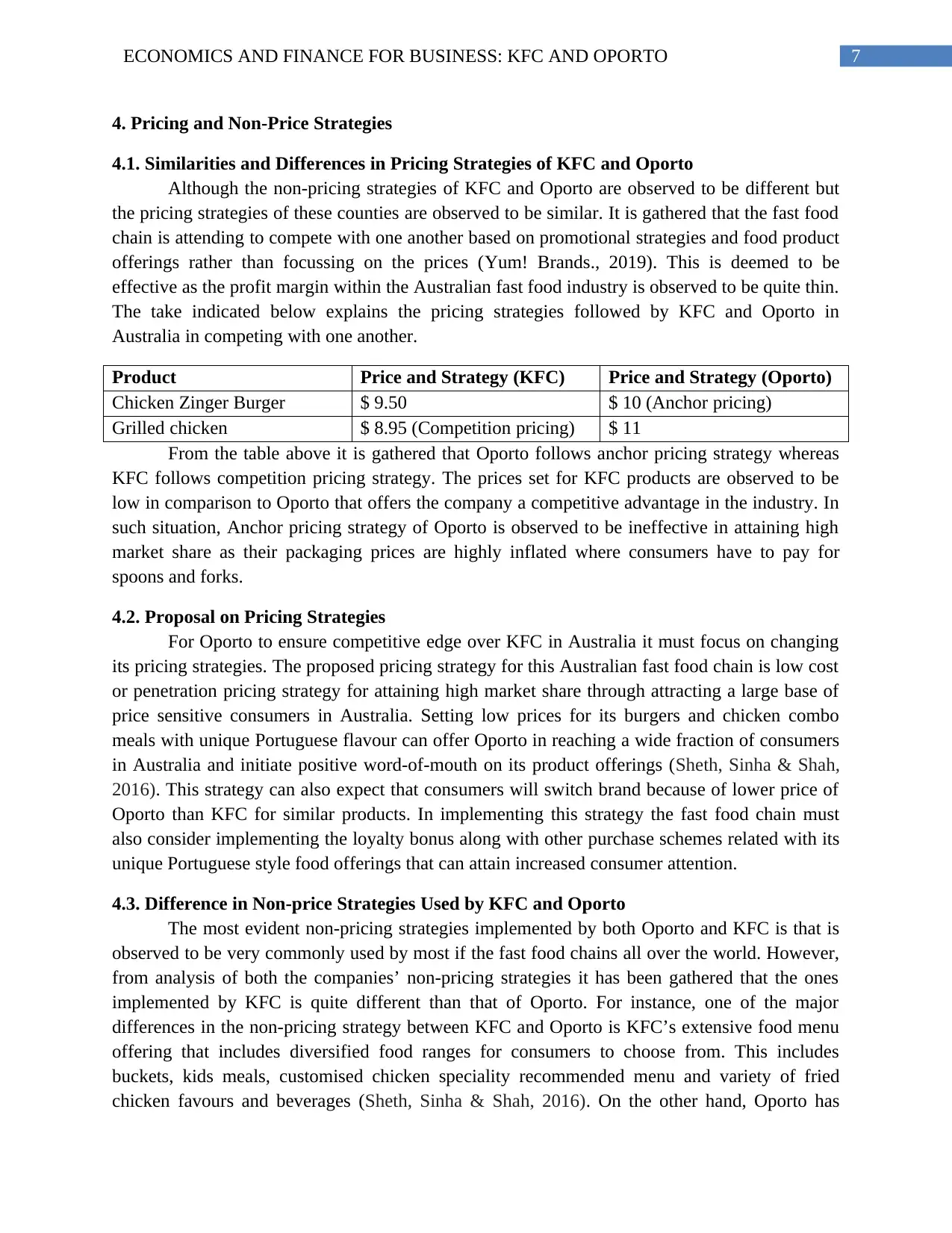
7ECONOMICS AND FINANCE FOR BUSINESS: KFC AND OPORTO
4. Pricing and Non-Price Strategies
4.1. Similarities and Differences in Pricing Strategies of KFC and Oporto
Although the non-pricing strategies of KFC and Oporto are observed to be different but
the pricing strategies of these counties are observed to be similar. It is gathered that the fast food
chain is attending to compete with one another based on promotional strategies and food product
offerings rather than focussing on the prices (Yum! Brands., 2019). This is deemed to be
effective as the profit margin within the Australian fast food industry is observed to be quite thin.
The take indicated below explains the pricing strategies followed by KFC and Oporto in
Australia in competing with one another.
Product Price and Strategy (KFC) Price and Strategy (Oporto)
Chicken Zinger Burger $ 9.50 $ 10 (Anchor pricing)
Grilled chicken $ 8.95 (Competition pricing) $ 11
From the table above it is gathered that Oporto follows anchor pricing strategy whereas
KFC follows competition pricing strategy. The prices set for KFC products are observed to be
low in comparison to Oporto that offers the company a competitive advantage in the industry. In
such situation, Anchor pricing strategy of Oporto is observed to be ineffective in attaining high
market share as their packaging prices are highly inflated where consumers have to pay for
spoons and forks.
4.2. Proposal on Pricing Strategies
For Oporto to ensure competitive edge over KFC in Australia it must focus on changing
its pricing strategies. The proposed pricing strategy for this Australian fast food chain is low cost
or penetration pricing strategy for attaining high market share through attracting a large base of
price sensitive consumers in Australia. Setting low prices for its burgers and chicken combo
meals with unique Portuguese flavour can offer Oporto in reaching a wide fraction of consumers
in Australia and initiate positive word-of-mouth on its product offerings (Sheth, Sinha & Shah,
2016). This strategy can also expect that consumers will switch brand because of lower price of
Oporto than KFC for similar products. In implementing this strategy the fast food chain must
also consider implementing the loyalty bonus along with other purchase schemes related with its
unique Portuguese style food offerings that can attain increased consumer attention.
4.3. Difference in Non-price Strategies Used by KFC and Oporto
The most evident non-pricing strategies implemented by both Oporto and KFC is that is
observed to be very commonly used by most if the fast food chains all over the world. However,
from analysis of both the companies’ non-pricing strategies it has been gathered that the ones
implemented by KFC is quite different than that of Oporto. For instance, one of the major
differences in the non-pricing strategy between KFC and Oporto is KFC’s extensive food menu
offering that includes diversified food ranges for consumers to choose from. This includes
buckets, kids meals, customised chicken speciality recommended menu and variety of fried
chicken favours and beverages (Sheth, Sinha & Shah, 2016). On the other hand, Oporto has
4. Pricing and Non-Price Strategies
4.1. Similarities and Differences in Pricing Strategies of KFC and Oporto
Although the non-pricing strategies of KFC and Oporto are observed to be different but
the pricing strategies of these counties are observed to be similar. It is gathered that the fast food
chain is attending to compete with one another based on promotional strategies and food product
offerings rather than focussing on the prices (Yum! Brands., 2019). This is deemed to be
effective as the profit margin within the Australian fast food industry is observed to be quite thin.
The take indicated below explains the pricing strategies followed by KFC and Oporto in
Australia in competing with one another.
Product Price and Strategy (KFC) Price and Strategy (Oporto)
Chicken Zinger Burger $ 9.50 $ 10 (Anchor pricing)
Grilled chicken $ 8.95 (Competition pricing) $ 11
From the table above it is gathered that Oporto follows anchor pricing strategy whereas
KFC follows competition pricing strategy. The prices set for KFC products are observed to be
low in comparison to Oporto that offers the company a competitive advantage in the industry. In
such situation, Anchor pricing strategy of Oporto is observed to be ineffective in attaining high
market share as their packaging prices are highly inflated where consumers have to pay for
spoons and forks.
4.2. Proposal on Pricing Strategies
For Oporto to ensure competitive edge over KFC in Australia it must focus on changing
its pricing strategies. The proposed pricing strategy for this Australian fast food chain is low cost
or penetration pricing strategy for attaining high market share through attracting a large base of
price sensitive consumers in Australia. Setting low prices for its burgers and chicken combo
meals with unique Portuguese flavour can offer Oporto in reaching a wide fraction of consumers
in Australia and initiate positive word-of-mouth on its product offerings (Sheth, Sinha & Shah,
2016). This strategy can also expect that consumers will switch brand because of lower price of
Oporto than KFC for similar products. In implementing this strategy the fast food chain must
also consider implementing the loyalty bonus along with other purchase schemes related with its
unique Portuguese style food offerings that can attain increased consumer attention.
4.3. Difference in Non-price Strategies Used by KFC and Oporto
The most evident non-pricing strategies implemented by both Oporto and KFC is that is
observed to be very commonly used by most if the fast food chains all over the world. However,
from analysis of both the companies’ non-pricing strategies it has been gathered that the ones
implemented by KFC is quite different than that of Oporto. For instance, one of the major
differences in the non-pricing strategy between KFC and Oporto is KFC’s extensive food menu
offering that includes diversified food ranges for consumers to choose from. This includes
buckets, kids meals, customised chicken speciality recommended menu and variety of fried
chicken favours and beverages (Sheth, Sinha & Shah, 2016). On the other hand, Oporto has
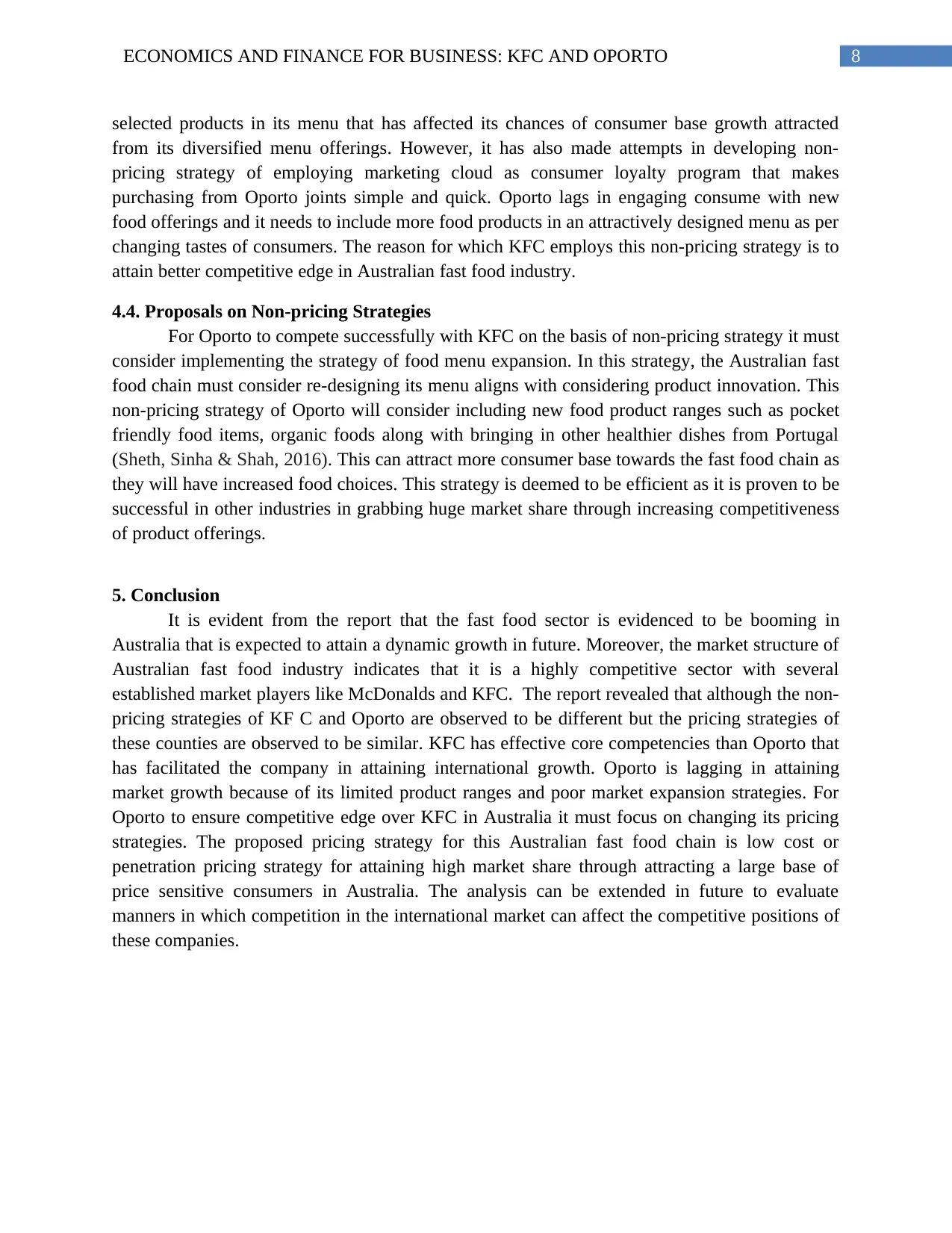
8ECONOMICS AND FINANCE FOR BUSINESS: KFC AND OPORTO
selected products in its menu that has affected its chances of consumer base growth attracted
from its diversified menu offerings. However, it has also made attempts in developing non-
pricing strategy of employing marketing cloud as consumer loyalty program that makes
purchasing from Oporto joints simple and quick. Oporto lags in engaging consume with new
food offerings and it needs to include more food products in an attractively designed menu as per
changing tastes of consumers. The reason for which KFC employs this non-pricing strategy is to
attain better competitive edge in Australian fast food industry.
4.4. Proposals on Non-pricing Strategies
For Oporto to compete successfully with KFC on the basis of non-pricing strategy it must
consider implementing the strategy of food menu expansion. In this strategy, the Australian fast
food chain must consider re-designing its menu aligns with considering product innovation. This
non-pricing strategy of Oporto will consider including new food product ranges such as pocket
friendly food items, organic foods along with bringing in other healthier dishes from Portugal
(Sheth, Sinha & Shah, 2016). This can attract more consumer base towards the fast food chain as
they will have increased food choices. This strategy is deemed to be efficient as it is proven to be
successful in other industries in grabbing huge market share through increasing competitiveness
of product offerings.
5. Conclusion
It is evident from the report that the fast food sector is evidenced to be booming in
Australia that is expected to attain a dynamic growth in future. Moreover, the market structure of
Australian fast food industry indicates that it is a highly competitive sector with several
established market players like McDonalds and KFC. The report revealed that although the non-
pricing strategies of KF C and Oporto are observed to be different but the pricing strategies of
these counties are observed to be similar. KFC has effective core competencies than Oporto that
has facilitated the company in attaining international growth. Oporto is lagging in attaining
market growth because of its limited product ranges and poor market expansion strategies. For
Oporto to ensure competitive edge over KFC in Australia it must focus on changing its pricing
strategies. The proposed pricing strategy for this Australian fast food chain is low cost or
penetration pricing strategy for attaining high market share through attracting a large base of
price sensitive consumers in Australia. The analysis can be extended in future to evaluate
manners in which competition in the international market can affect the competitive positions of
these companies.
selected products in its menu that has affected its chances of consumer base growth attracted
from its diversified menu offerings. However, it has also made attempts in developing non-
pricing strategy of employing marketing cloud as consumer loyalty program that makes
purchasing from Oporto joints simple and quick. Oporto lags in engaging consume with new
food offerings and it needs to include more food products in an attractively designed menu as per
changing tastes of consumers. The reason for which KFC employs this non-pricing strategy is to
attain better competitive edge in Australian fast food industry.
4.4. Proposals on Non-pricing Strategies
For Oporto to compete successfully with KFC on the basis of non-pricing strategy it must
consider implementing the strategy of food menu expansion. In this strategy, the Australian fast
food chain must consider re-designing its menu aligns with considering product innovation. This
non-pricing strategy of Oporto will consider including new food product ranges such as pocket
friendly food items, organic foods along with bringing in other healthier dishes from Portugal
(Sheth, Sinha & Shah, 2016). This can attract more consumer base towards the fast food chain as
they will have increased food choices. This strategy is deemed to be efficient as it is proven to be
successful in other industries in grabbing huge market share through increasing competitiveness
of product offerings.
5. Conclusion
It is evident from the report that the fast food sector is evidenced to be booming in
Australia that is expected to attain a dynamic growth in future. Moreover, the market structure of
Australian fast food industry indicates that it is a highly competitive sector with several
established market players like McDonalds and KFC. The report revealed that although the non-
pricing strategies of KF C and Oporto are observed to be different but the pricing strategies of
these counties are observed to be similar. KFC has effective core competencies than Oporto that
has facilitated the company in attaining international growth. Oporto is lagging in attaining
market growth because of its limited product ranges and poor market expansion strategies. For
Oporto to ensure competitive edge over KFC in Australia it must focus on changing its pricing
strategies. The proposed pricing strategy for this Australian fast food chain is low cost or
penetration pricing strategy for attaining high market share through attracting a large base of
price sensitive consumers in Australia. The analysis can be extended in future to evaluate
manners in which competition in the international market can affect the competitive positions of
these companies.
⊘ This is a preview!⊘
Do you want full access?
Subscribe today to unlock all pages.

Trusted by 1+ million students worldwide
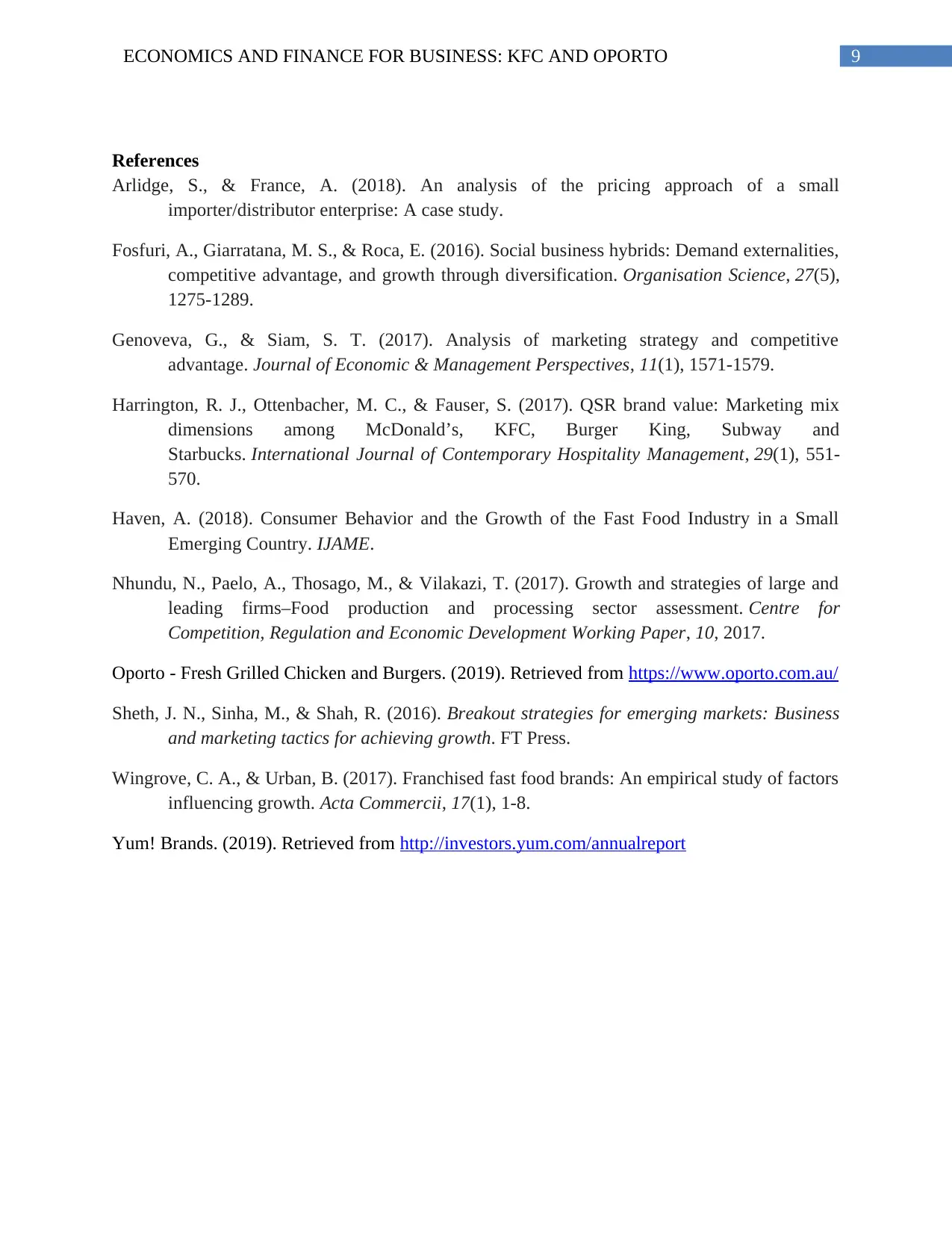
9ECONOMICS AND FINANCE FOR BUSINESS: KFC AND OPORTO
References
Arlidge, S., & France, A. (2018). An analysis of the pricing approach of a small
importer/distributor enterprise: A case study.
Fosfuri, A., Giarratana, M. S., & Roca, E. (2016). Social business hybrids: Demand externalities,
competitive advantage, and growth through diversification. Organisation Science, 27(5),
1275-1289.
Genoveva, G., & Siam, S. T. (2017). Analysis of marketing strategy and competitive
advantage. Journal of Economic & Management Perspectives, 11(1), 1571-1579.
Harrington, R. J., Ottenbacher, M. C., & Fauser, S. (2017). QSR brand value: Marketing mix
dimensions among McDonald’s, KFC, Burger King, Subway and
Starbucks. International Journal of Contemporary Hospitality Management, 29(1), 551-
570.
Haven, A. (2018). Consumer Behavior and the Growth of the Fast Food Industry in a Small
Emerging Country. IJAME.
Nhundu, N., Paelo, A., Thosago, M., & Vilakazi, T. (2017). Growth and strategies of large and
leading firms–Food production and processing sector assessment. Centre for
Competition, Regulation and Economic Development Working Paper, 10, 2017.
Oporto - Fresh Grilled Chicken and Burgers. (2019). Retrieved from https://www.oporto.com.au/
Sheth, J. N., Sinha, M., & Shah, R. (2016). Breakout strategies for emerging markets: Business
and marketing tactics for achieving growth. FT Press.
Wingrove, C. A., & Urban, B. (2017). Franchised fast food brands: An empirical study of factors
influencing growth. Acta Commercii, 17(1), 1-8.
Yum! Brands. (2019). Retrieved from http://investors.yum.com/annualreport
References
Arlidge, S., & France, A. (2018). An analysis of the pricing approach of a small
importer/distributor enterprise: A case study.
Fosfuri, A., Giarratana, M. S., & Roca, E. (2016). Social business hybrids: Demand externalities,
competitive advantage, and growth through diversification. Organisation Science, 27(5),
1275-1289.
Genoveva, G., & Siam, S. T. (2017). Analysis of marketing strategy and competitive
advantage. Journal of Economic & Management Perspectives, 11(1), 1571-1579.
Harrington, R. J., Ottenbacher, M. C., & Fauser, S. (2017). QSR brand value: Marketing mix
dimensions among McDonald’s, KFC, Burger King, Subway and
Starbucks. International Journal of Contemporary Hospitality Management, 29(1), 551-
570.
Haven, A. (2018). Consumer Behavior and the Growth of the Fast Food Industry in a Small
Emerging Country. IJAME.
Nhundu, N., Paelo, A., Thosago, M., & Vilakazi, T. (2017). Growth and strategies of large and
leading firms–Food production and processing sector assessment. Centre for
Competition, Regulation and Economic Development Working Paper, 10, 2017.
Oporto - Fresh Grilled Chicken and Burgers. (2019). Retrieved from https://www.oporto.com.au/
Sheth, J. N., Sinha, M., & Shah, R. (2016). Breakout strategies for emerging markets: Business
and marketing tactics for achieving growth. FT Press.
Wingrove, C. A., & Urban, B. (2017). Franchised fast food brands: An empirical study of factors
influencing growth. Acta Commercii, 17(1), 1-8.
Yum! Brands. (2019). Retrieved from http://investors.yum.com/annualreport
1 out of 10
Related Documents
Your All-in-One AI-Powered Toolkit for Academic Success.
+13062052269
info@desklib.com
Available 24*7 on WhatsApp / Email
![[object Object]](/_next/static/media/star-bottom.7253800d.svg)
Unlock your academic potential
Copyright © 2020–2025 A2Z Services. All Rights Reserved. Developed and managed by ZUCOL.




